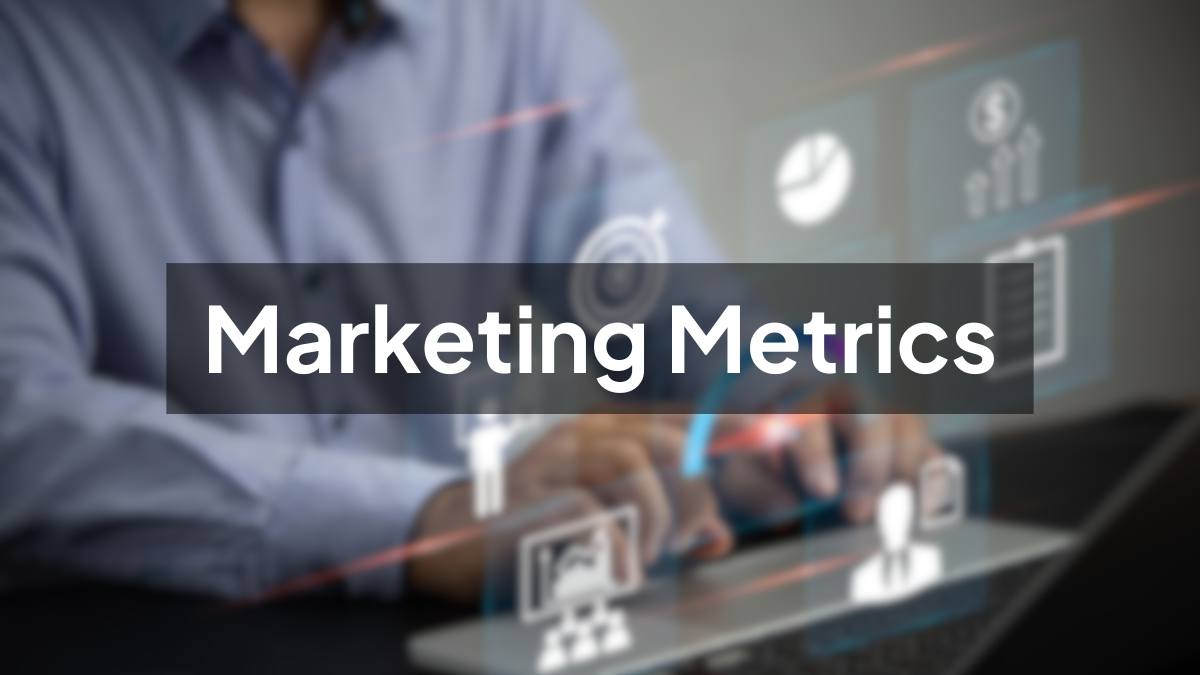Ever run a campaign and wonder afterward, “Wait… did that even work?”
Yeah, we’ve all been there.
You spend hours writing content, designing ads, crafting emails, and posting on socials, and then hope for the best. Maybe you get a few likes, maybe your website traffic ticks up a little, but you’re left staring at your screen asking, “Is this actually doing anything for the business?”
That’s exactly where marketing metrics come in.
In digital marketing today, you can’t afford to “go with your gut” alone. Everything is trackable, from how many people saw your ad to how many actually bought because of it. And if you know how to read those numbers right, you can make way better decisions, stop wasting budget, and grow faster.
So, what are marketing metrics, really?
They’re the numbers behind your marketing activities, the hard data that tells you what’s working, what’s not, and where you should double down.
In this blog, we’re going to break down what marketing metrics are, how they differ from KPIs (yup, there’s a difference), and how they fit into your overall strategy without making your head spin.
Table of Contents
What are Marketing Metrics?
Let’s keep it simple.
Marketing metrics are numbers that show how well your marketing is performing.
They could be as basic as how many people visited your website, or as advanced as your customer acquisition cost across a 90-day ad funnel. If you can measure it, and it’s tied to your marketing effort, it’s a marketing metric.
And in a world where digital marketing moves fast and budgets are tight, knowing what to track is half the battle.
Metrics vs KPIs, What’s the Deal?
Here’s where things get a little fuzzy for some folks. You’ve probably heard the terms metrics and KPIs tossed around like they’re the same thing. But they’re not.
- Metrics are all the data points you can track.
- KPIs (Key Performance Indicators) are the most important metrics, the ones that directly reflect whether you’re reaching your goals.
Think of it like this:
If marketing metrics are your full report card, KPIs are your final grades.
For example:
- You might track email open rates as a metric.
- But if your campaign goal is conversions, your KPI might be email conversion rate.
Both matter, but one is the real measure of success.
Also Read: Top Performance Marketing Metrics
How Do Marketing Metrics Fit Into Strategy?
You wouldn’t drive a car without a speedometer, right? Same goes for running a marketing campaign without tracking metrics.
When you have clear metrics in place:
- You know if your strategy is moving in the right direction.
- You can catch underperforming campaigns early.
- You’re able to justify your efforts to clients, bosses, or stakeholders with real numbers (not just gut feelings).
The right marketing metrics help you stay focused on what truly matters, not just doing “stuff,” but doing the right stuff that leads to growth.
And the best part? You don’t need a PhD in data science to start using them. You just need a clear goal, the right tools, and a bit of curiosity.
Why are Marketing Metrics Important?
Here’s the honest truth: marketing without metrics is just guesswork. And guesswork doesn’t scale.
1. Metrics Guide Decision-Making
Let’s say your blog is bringing in 50,000 visitors a month. That sounds awesome, but how many of those actually become leads? Or better yet, customers?
Tracking conversion metrics helps you pinpoint whether that traffic is just noise or if it’s driving business growth. If the answer’s “not really”, maybe your CTAs need work or your traffic source isn’t high-intent.
2. Metrics Protect ROI
Every dollar spent on marketing should return something, whether it’s leads, sales, or loyal customers.
Good metrics help you:
- Identify high-performing channels (so you can double down)
- Kill underperforming campaigns before they burn your budget
- Show your boss/client real results (not just “we posted on Instagram”)
Also Read: Digital Marketing ROI
3. Metrics Align Marketing With Business Goals
When your marketing team and sales team track different things, misalignment creeps in.
For example: Marketing says “We generated 1,000 MQLs!”
Sales says, “None of these leads are converting.”
With shared metrics and definitions (e.g., what qualifies as a lead?), you avoid silos and finger-pointing, and instead, work toward revenue together.
Key Categories of Marketing Metrics
To avoid overwhelm, let’s organize marketing metrics into categories based on the stage of the funnel and what they tell you. This makes it easier to track, report, and optimize.
1. Awareness & Reach Metrics
These metrics tell you how visible your brand is and how many people are seeing your content.
📈 Impressions
How many times your content (ad, post, page) was displayed. High impressions don’t always mean high engagement, but they’re the first step.
💡 Brand Awareness
Often measured via surveys, branded search volume, or social mentions. Tricky to track directly but crucial for long-term growth.
📲 Social Media Engagement
Likes, shares, comments, and saves, indicators that your content is resonating.
🔍 First-Page Keyword Rankings
How many of your pages rank in the top 10 search results? It’s a strong indicator of SEO visibility and content strength.
Also Read: 30 Keyword Research Tools
2. Engagement & Traffic Metrics
Once you’ve got attention, what are users doing with it?
🌐 Website Traffic
Track total sessions, unique visitors, and traffic sources (organic, paid, social, etc.). Helps you identify what’s driving people to your site.
⏱ Time on Site & Bounce Rate
- Time on site tells you if users are sticking around.
- Bounce rate shows how many leave after seeing just one page (a high rate might be a red flag).
📊 Month-over-Month (MoM) Traffic Growth
Is your traffic growing steadily, or are you plateauing? Look at this metric to see your directional momentum.
🔗 Quality of Inbound Links
Backlinks from credible sites boost your SEO authority, and can drive referral traffic. Quality > quantity here.
3. Lead Generation & Pipeline Metrics
If you’re in B2B or high-ticket B2C, your funnel might involve sales calls or demos, not just purchases.
🧲 Marketing Qualified Leads (MQLs)
These leads meet your marketing criteria (downloaded a guide, signed up for a webinar, etc.). They’re interested but not yet ready to buy.
🎯 Sales Qualified Leads (SQLs)
Leads that the sales team agrees are legit opportunities. These are MQLs that passed the next level of scrutiny.
🔄 Lead-to-Customer Conversion Rate
What percentage of leads turn into paying customers? This reveals how effective your entire funnel is.
📅 Second-Stage Meetings
In complex sales cycles, tracking meetings beyond the first one can show buyer intent.
💼 Deals Closed From Marketing
Exactly what it sounds like: how many closed deals can be attributed to marketing efforts.
📉 MQL to SQL Ratio
A low ratio might mean you’re attracting the wrong kind of leads, time to adjust your targeting or lead scoring.
4. Conversion Metrics
These tell you whether your efforts are leading people to take action.
🔁 Conversion Rate (By Channel or Campaign)
What % of visitors take your desired action, like signing up, buying, or scheduling a call. Break this down by channel to spot performance differences.
💰 Value per Visit
Revenue or value generated divided by number of visits. Helps you understand the quality of your traffic.
🌐 Website Conversion Rate
Overall site-wide metric, useful to benchmark and track long-term improvements.
👉 CTA Click-Through Rate
How often users click your main call-to-action. Weak CTAs = low clicks = lower conversions.
5. Marketing Performance & ROI Metrics
Now we’re getting into the money talk. These metrics help you justify budgets, prove results, and decide where to invest.
💸 Cost Per Lead (CPL)
How much does it cost to acquire a lead through marketing? A high CPL might be fine for high-ticket products, but for low-cost items, it needs to stay lean.
📈 Return on Investment (ROI)
The holy grail. For every ₹1 you spend, how much are you getting back? ROI can be calculated overall or per campaign/channel. The formula is simple:
(Revenue – Cost) / Cost × 100
🧮 Customer Lifetime Value (CLV)
How much is a customer worth over their entire relationship with your brand? This long-term view is critical for subscription-based businesses or those with high repeat purchase rates.
📉 Customer Acquisition Cost (CAC)
Total sales + marketing costs divided by number of new customers. This paired with CLV tells you if your marketing is sustainable.
⚖️ CLV:CAC Ratio
This is where things get real. If your CLV is 3x your CAC, you’re in a healthy zone. If it’s less than 1:1… something’s broken.
🧭 Multi-Touch Attribution
This tracks how different touchpoints (ads, emails, blogs, etc.) contribute to a conversion. Rarely does one channel do it all, attribution helps you distribute credit fairly.
6. Retention & Satisfaction Metrics
Most marketers obsess over acquisition, but retention is where real profit lives.
🔄 Customer Churn Rate
What % of customers leave over a specific period? Especially important for SaaS, membership, or subscription models.
🗣 Net Promoter Score (NPS)
A simple survey asking: “How likely are you to recommend us?”
Scores range from -100 to +100. A positive NPS = strong word-of-mouth potential.
♻️ Customer Lifetime Value (CLV)
Yes, we already mentioned this, but it’s just as relevant here. Repeat purchases, upsells, and loyalty are all wrapped into CLV.

Enroll Now: Advanced Digital Marketing Course
How to Choose the Right Marketing Metrics
With dozens (even hundreds) of metrics to track, it’s easy to get overwhelmed. So how do you choose the right ones?
1. Align With the Funnel Stage
- TOFU (Top of Funnel): Focus on reach, impressions, and website traffic.
- MOFU (Middle of Funnel): Look at engagement, MQLs, and email sign-ups.
- BOFU (Bottom of Funnel): Prioritize SQLs, conversions, and revenue.
2. Set SMART Goals
Before tracking anything, be clear on your objective.
A goal like “Grow Instagram” is vague. But “Grow Instagram engagement rate by 25% in 3 months” is specific, measurable, and trackable.
3. Choose Based on Channels
Each channel demands its own metric set:
- SEO? Organic traffic, rankings, dwell time
- Paid Ads? CTR, CPL, ROAS
- Email? Open rate, click-through, unsubscribes
- Social? Engagement rate, follower growth, shares
Also Read: Top Marketing Channels
Common Mistakes to Avoid
Let’s be real, everyone makes these at some point:
1. Tracking Only Vanity Metrics
Pageviews, likes, followers, nice, but they don’t always impact the bottom line. Use them, but don’t rely on them.
2. Ignoring Qualitative Data
Metrics show what happened. But why it happened? That often lives in user feedback, customer interviews, or heatmaps.
3. Not Using Benchmarks
Without industry benchmarks or historical comparisons, data lacks context. Is a 2% CTR good or bad? Depends on the niche.
How to Analyze and Act on Marketing Metrics
Data is only powerful when you actually use it.
1. Set Up Dashboards
Use tools like:
- Google Analytics 4 for web data
- HubSpot or Salesforce for pipeline metrics
- Looker Studio (formerly Data Studio) for cross-platform reporting
Make dashboards that your team will actually use. Clean, visual, and regularly updated.
2. Use Reporting Frameworks
Don’t just pull data randomly. Stick to a cadence:
- Weekly: Micro-optimizations (ads, emails)
- Monthly: Campaign performance
- Quarterly: Strategic reviews
3. Turn Insights Into Action
Let’s say your blog bounce rate is high. That’s not the final insight. Ask:
- Is the content matching the keyword intent?
- Is the page loading too slowly?
- Are CTAs visible?
Metrics should lead to changes, not just reports.
Real-World Examples of Marketing Metrics in Action
1. Email Campaign Example: Jordan Craig
Brand: Jordan Craig (men’s streetwear)
Challenge: Managing a large, diverse email list required moving beyond one-size-fits-all campaigns.
Solution: Used AI to predict each subscriber’s next likely order date and segmented the audience into 40+ groups. Sent daily emails for two weeks before and after the predicted order date.
Result: Achieved a 54% year-over-year increase in email revenue within six months by focusing on open rates, click-through rates, and conversion rates as key metrics. (Source 1, Source 2)
Key Metrics: Open rate, click-through rate, conversion rate, revenue per subscriber
2. SEO Traffic Growth Example: Edelweiss Bakery
Brand: Edelweiss Bakery (local Florida bakery)
Challenge: Low online visibility despite a loyal customer base.
Solution: Partnered with an SEO agency to optimize on-page elements, conduct technical audits, redesign the homepage, expand site structure, build backlinks, and create an SEO-optimized blog.
Result: Grew organic traffic by 214% in just four months, with 230 new backlinks, demonstrating the impact of SEO metrics like organic traffic, keyword rankings, and backlinks. (Source)
Key Metrics: Organic traffic, keyword rankings, backlinks, session growth
3. ROI Improvement Example: Jackery (Amazon Ads)
Brand: Jackery (portable power solutions)
Challenge: Needed to expand reach beyond a saturated primary audience segment.
Solution: Used Amazon Marketing Cloud and shopping insights to identify new audiences and create tailored ad campaigns.
Result: Achieved growth in advertising performance and improved ROI by closely tracking metrics such as return on ad spend (ROAS), conversion rates, and customer acquisition cost. (Source)
Key Metrics: ROI, ROAS, conversion rate, customer acquisition cost
Each example highlights how tracking specific marketing metrics, whether for email campaigns, SEO, or ROI, leads to measurable business growth.

Enroll Now: Generative AI for Marketers Course
Conclusion
At the end of the day, marketing metrics aren’t just numbers, they’re signals. They show you where you’re winning, where you’re wasting time, and where your next big opportunity lies.
Start by choosing a few key metrics that map to your funnel. Measure consistently. And most importantly, use those insights to optimize.
Because marketing that doesn’t get measured? Usually doesn’t improve.
FAQs: What are Marketing Metrics
1. What are the most important marketing metrics for beginners?
Start with basics: traffic, bounce rate, conversions, and cost-per-lead. These give you a solid foundation.
2. How do I know which metrics matter for my business?
Look at your goals and funnel. Are you focused on awareness, leads, or sales? Pick metrics that directly support those outcomes.
3. What’s the difference between KPIs and marketing metrics?
Metrics are all the data you can measure. KPIs are the handful that truly move the needle for your business.
4. How often should I track my marketing metrics?
Weekly for tactical metrics (ads, emails). Monthly for campaign reviews. Quarterly for strategy adjustments.
5. Which tools are best for tracking marketing performance?
Google Analytics, HubSpot, Ahrefs, SEMrush, Meta Ads Manager, and Looker Studio are a great starting mix.
6. Can small businesses benefit from tracking marketing metrics?
100%. In fact, small businesses often see faster improvements because they can pivot quickly based on data.

